For the remainder of summer Video Days piles in a vehicle and for those who can’t take a vacation, journeys to unfamiliar places with comedies about strangers in strange lands.
BEVERLY HILLS COP II (1987) is the antithesis of everything that made Beverly Hills Cop (1984), for its off-the-rack fit and off-the-cuff style, endearing. Glossy and noisy, it’s also unfunny, it’s single laugh a credit to Detroit homicide detective Gilbert R. Hill, not superstar Eddie Murphy or any of the actors surrounding him this time around. To put the video in the “comedy” section is a stretch, but in spite of its worst intentions, this sequel isn’t a mere retread of the original, for worse and better.
Like the dimestore paperbacks it tore a few pages from, Beverly Hills Cop left plenty of room for a sequel, which became inevitable after the film opened in December 1984 and held the top spot at the U.S. box office for a remarkable fourteen of fifteen weekends (Witness starring Harrison Ford briefly unseating it in March 1985 before audiences recrowned Cop #1). While producers Don Simpson and Jerry Bruckheimer prepped their next film, Top Gun (1986), and Eddie Murphy cut an R&B album with producer Rick James, Paramount Pictures oiled the machinery that would ship a sequel to market after Murphy decided what movie he wanted to make next. In the summer of 1985, the studio commissioned the tandem of Bud Shrake & Dan Jenkins to write a script. Having met in high school in Fort Worth, Texas in the late 1940s, the sportswriters had taken their talents to Hollywood, where they discovered they could earn as much as $100,000 for a first draft and finance a lifestyle in the Lone Star State writing about sports, publishing westerns or satiric novels, and playing golf.
In the early 1980s, Shrake & Jenkins collaborated on several screenplays for hire (Slim and None was a Depression-era comedy which a pairing of Richard Pryor and Michael Caine was proposed). Their commission to write the sequel to Beverly Hills Cop looked like it would be the duo’s first shared screen credit, even after their initial pitch was rejected. In what they called Scotland Yard Cop, Axel Foley would’ve traveled to the Old Smoke and turned the town upside down, but according to Jenkins, Murphy had visited London, gotten into a fight with his girlfriend and spending most of the time in his hotel, hated the city. In the story Shrake & Jenkins would be hired to write, Foley pursues a Detroit gangster named Tony Lulu to Beverly Hills, where the bad guy operates a private security firm that moonlights as a burglary ring. Re-teamed with Rosewood & Taggart, Axel goes undercover as a security guard, engaging an officer named Lucy as a love interest. Beverly Hills Security Guard featured chases and comedy (a recurring joke involved a man described as looking like TV producer Aaron Spelling getting his Rolls-Royce crashed into). Shrake & Jenkins’ second draft, completed in December 1985, cut back on the chases and the comedy as well, Don Simpson telling the Texans their humorous contributions were unnecessary because “Eddie be funny,” which Shrake & Jenkins would repeat to each other over the years whenever they needed a laugh: “Eddie be funny.”
Neither Murphy nor his manager Robert D. Wachs, a promoter who took credit for discovering Murphy as a teenage standup comic, thought much of the Shrake & Jenkins screenplay, particularly the female love interest, something Murphy resisted or struggled incorporating into his work until the romantic comedy Boomerang (1992). In February 1986, Paramount turned to screenwriter Larry Ferguson, whose work-for-hire on action films like Highlander (1986) was full of red-blooded males. The following month, Ferguson met with Wachs to be pitched bare bones for an entirely new story, in which Axel returns to Beverly Hills to solve a series of armed robberies by a gang knocking over scores in the order of the alphabet, hence their name, the Alphabet Gang. Between April and August 1986, Ferguson wrote several drafts of Beverly Hills Cop II bringing what he was particularly gifted at: structure. While Ferguson was writing, Top Gun opened in May 1986 and began its slow but steady run toward finishing the highest grossing movie of the year. Its director, Tony Scott, a veteran of commercials, would get work for years based on how cool the fighter jets and Tom Cruise looked on film, and he let Simpson and Bruckheimer know that for his next job, he’d like to work with the biggest star on the planet in the sequel to Beverly Hills Cop.
Principal photography fast approaching to make the Memorial Day weekend release they’d staked for 1987, Paramount added Dennis Klein to the payroll, tasking the staff writer from All In the Family and head writer on the sitcom Mary Hartman, Mary Hartman with taking over for Ferguson and punching up the script’s humor, the studio apparently not getting the memo from Simpson/ Bruckheimer that “Eddie be funny.” In September 1986, the producers put in a call to Warren Skaaren to perform emergency triage on the script. Based in Austin, Texas, Skaaren had written as many as ten drafts of Top Gun after the screenwriters who’d received sole credit turned in their work. Skaaren was heavily in demand, but taking a break from rewrite duties on Beetlejuice (1988) and work on a comedy titled Flawless for Jane Fonda, Skaaren had time to take a two-week pass on Beverly Hills Cop II. He was tasked with dialing in a detective story and getting Axel Foley back to Beverly Hills quicker, which Skaaren did by introducing Lt. Bogomil on the trail of the Alphabet Gang, reinforcing his friendship with Axel. When he’s shot by the gang’s femme fatale, Foley drops everything and gets to Beverly Hills to help.
Skaaren introduced a new character, Bogomil’s daughter Jan, who was Foley’s age and if not a love interest, kept the Detroit cop’s ties to her family in focus. Simpson thought that Skaaren had given Jan a little too much focus, taking the spotlight away from Eddie Murphy, and played by Alice Adair, the character would be reduced to three scenes as decor. Tony Scott favored more action, as well as a scene that would take place at the Playboy Mansion, with a volleyball game between the Playboy Bunnies generating the sizzle that the men's beach volleyball match had in Top Gun. Skaaren delivered a second draft in three days and a third draft later in the week, by his estimation, originating a large chunk of the dialogue over what he calculated was about ten days, not including improvising new material over the phone when called for help. In addition to Gilbert Hill, cast members returning for the sequel would be Judge Reinhold, John Ashton, Ronny Cox and Paul Reiser. They were joined by Jürgen Prochnow, Brigitte Nielsen and Dean Stockwell as the film’s villains, Allen Garfield as the antagonistic new chief of the Beverly Hills Police Department, and Robert Pastorelli, Gilbert Gottfried and Chris Rock included to bring some comic punch
Beverly Hills Cop II commenced filming in November 1986 on a publicized budget of $27 million. While director Martin Brest had brought Beverly Hills Cop in under budget, some reports put Cop II over budget by as much as $4 million. Despite costing more than double what Cop I had, production again took place in Los Angeles. The jewelry store robbery was shot at the Max Factor Museum in Hollywood. Axel’s credit card sting in Detroit was filmed at the Formosa Cafe in West Hollywood. Interiors for the police precinct house in Detroit were shot in the same building in Los Angeles, which had warehouse space suitable for film production. The house Axel “steals” really was in Beverly Hills, though at 614 Walden Drive as opposed to “1603 Hillcrest Road.” A French restaurant in Hollywood then called 385 North was utilized for the interior of the upscale strip club. In addition to the Playboy Mansion, the oil patch in Baldwin Hills and Santa Anita Racetrack provided a splash of L.A. scenery.
In February 1987, a four year legal battle to sort out the authors of Beverly Hills Cop II began when the Writer’s Guild of America announced that screenplay credit would be shared by Larry Ferguson and Warren Skaaren, with story credit going to Bud Shrake & Dan Jenkins. Millions of dollars in residuals hanging in the balance, Ferguson filed for arbitration, dubious that Skaaren’s work on the screenplay amounted to anything more than a routine polish. Precedence was on his side. The WGA was supposed to protect screenwriters like Ferguson who’d done the labor intensive work of structuring a film story against parties seeking a credit for dialogue or scene enhancements, which producers, directors, actors, studio executives, attorneys, security guards and anyone related to them could contribute effortlessly. Things would get tangled quickly. In March, the WGA revealed that a previously unseen memo from Paramount executive David Kirkpatrick credited Eddie Murphy & Robert D. Wachs for the story to Beverly Hills Cop II. Maintaining a co-screenplay credit for Skaaren, the WGA revoked Shrake & Jenkins’ story credit and awarded it to Murphy and his manager. When Beverly Hills Cop II hit theaters, writing credits read “Screenplay by Larry Ferguson and Warren Skaaren” and “Story by Eddie Murphy & Robert D. Wachs.”
In a lawsuit Ferguson filed in Los Angeles Superior Court against the WGA, he contended that Murphy had offered no story input, Wachs minimal input, and Skaaren’s contributions fell under the thirty-three percent rule the WGA applied to gauge whether a screenwriter’s contributions to the shooting script were enough to warrant credit. For example, for a scene written by Ferguson set in the precinct house where Jeffrey covers for Axel while he’s secretly in Los Angeles, it wouldn’t matter if 100% of Ferguson’s dialogue was rewritten. If the scene still took place at the precinct house with Jeffrey covering for Axel, revisions would unlikely amount to thirty-three percent as far as the writers’ union was concerned. Based on these rules, at least two of the WGA’s three arbitrators sided with Ferguson. Screenwriter Nicholas Meyer had done significant rewrite work on Fatal Attraction (1987) without a writing credit, while Leslie Dixon’s rewrite of the comedy Blind Date (1987) had warranted her a screenplay credit. Meyer took issue with Murphy & Wachs’ grab for credit and concluded that Skaaren’s polishes to Beverly Hills Cop II amounted to 5% of the shooting script.
Dixon put Skaaren’s contributions at 15%. She found four changes in story or plot structure, only two of which Skaaren could lay claim to. In Dixon’s professional opinion, most of Skaaren’s work amounted to cutting Ferguson. Nevertheless, the WGA held firm in their decision. In July, a judge would allow Shrake & Jenkins to join Ferguson’s lawsuit disputing the credit. In November, the court found that Skaaren would continue to share screenplay credit with Ferguson, but that Shrake & Jenkins warranted a new arbitration to sort out story credit. The WGA appealed the lower court’s decision and in January 1991, it was determined that the courts had no authority to “second guess” the union when it came to credits, whatever political calculus had been used to determine them. Professional writers fired from a project rarely admitted their work required a substantive redo, particularly if they didn't think the new drafts were good. Bud Shrake maintained that the shooting script for Beverly Hills Cop II followed the storyline he’d crafted with Jenkins, but considering the Shrake & Jenkins story concerned Axel going undercover as a security guard, while Ferguson had Axel chasing high-tech thieves who’d shot Bogomil, Shrake’s allegation doesn’t hold water.
Newspaper reviews for Beverly Hills Cop II were wholly negative. Gene Siskel & Roger Ebert, who’d turned two thumbs down for Beverly Hills Cop, were hostile to the sequel. Siskel stated, “It actually hurt my eyes and ears to watch this film.” Ebert allowed that the original managed to get about half of its conceit on screen while the sequel got none of it. He opined, “This movie is high-tech, assembly line moviemaking by the numbers. It has no creativity, it has no acting, it has no humor.” Writing for the New York Times, Janet Maslin admitted that Cop II had at least some of the original’s appeal while lacking its novelty. She credited Murphy’s riffs as being fresh but acknowledged the sequel was notably more misogynistic. Rival studios had given Paramount a wide berth and Beverly Hills Cop II held the #1 spot at the U.S. box office for three weekends before being pushed aside by Predator and The Witches of Eastwick. It spent nine weekends among the top ten grossing films in the country, a drop from the twenty-eight weekends Beverly Hills Cop had held in the top ten. Interviewed by Rolling Stone magazine in 1989, Eddie Murphy offered his postmortem: “Beverly Hills Cop II was probably the most successful mediocre picture in history. It made $250 million worldwide, and it was a half-assed movie. Cop II was basically a retread of Cop I, but it wasn’t as spontaneous or funny.” Promoting a legacy sequel, Beverly Hills Cop: Axel F (2024) on Late Night with Seth Meyers, Murphy would revise his assessment, stating, “the first two Beverly Hills Cops were really good.”
If Beverly Hills Cop was a summer camp in which all involved seemed to be having the time of their lives, Beverly Hills Cop II is the back-to-school hangover, with everyone wearing clothes they’re not comfortable in yet, disoriented over new schedules, hostile to be here. Most of the cast is out of rhythm except Ronny Cox, his discipline and ability to do more with less not appreciated nearly enough. Eddie Murphy could have learned a lot from an actor like Cox, but instead of coming to work prepared, is playing himself two years after the success of Beverly Hills Cop: annoyed, overwhelmed, jaded. As his wits have dulled, so have Foley’s. Wanting the story credit, Murphy and Wachs might have actually used that—Sylvester Stallone addressed the doubts and obstacles burdening him as an actor by having Rocky Balboa overcome similar doubts and obstacles in Rocky II (1979) — but neither were qualified writers. Slick but humorless, Cop II doesn’t work as an action thriller either, stringing together a series of preposterous robberies perpetrated by bad guys whose motivations are so random and relationship to Foley so sketchy they seem spliced in from a cable TV movie. Prochnow shares one scene with Murphy, while Nielsen, taking over the henchman role from Jonathan Banks in Cop I, would’ve been hapless if James Cameron had written her part, and by Larry Ferguson, is cast into the abyss.
As a standalone, Beverly Hills Cop II would be terrible, but as a sequel, with recurring characters getting together one more time, it does have its charms. In an era where actors could vanish from the public for a year or more between films, seeing Murphy, Reinhold, Ashton, and Cox together again is satisfying. The moments their characters talk about going marlin fishing, we can see the actors wish they were off this picture and doing just that. While Beverly Hills Cop had the gritty undertone of a seventies cop movie, Beverly Hills Cop II leaves no doubt which decade it was produced. The credit card receipt is practically posted to the screen. Cop II is shot, edited, and scored (once more by Harold Faltermeyer, who composed a propulsive electronic score this script is unworthy of) to terrific excess. Great import is placed on designer clothing, jewelry, foreign cars, firearms, and sunglasses. Tony Scott makes everyone and everything look cool. As an exercise in style, Beverly Hills Cop II is watchable, something apparent by the malodorous Beverly Hills Cop III (1994) which was not produced by Simpson/ Bruckheimer.
Video rental category: Comedy
Special interest: Stranger In A Strange Land


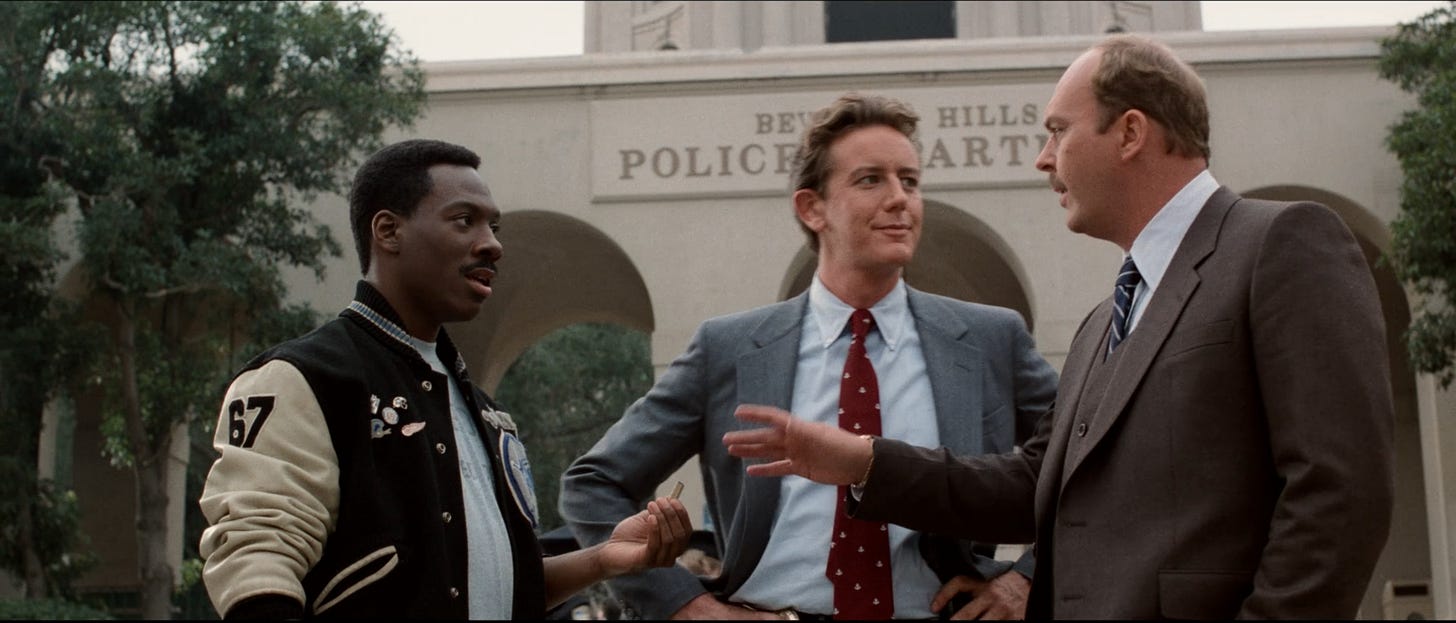
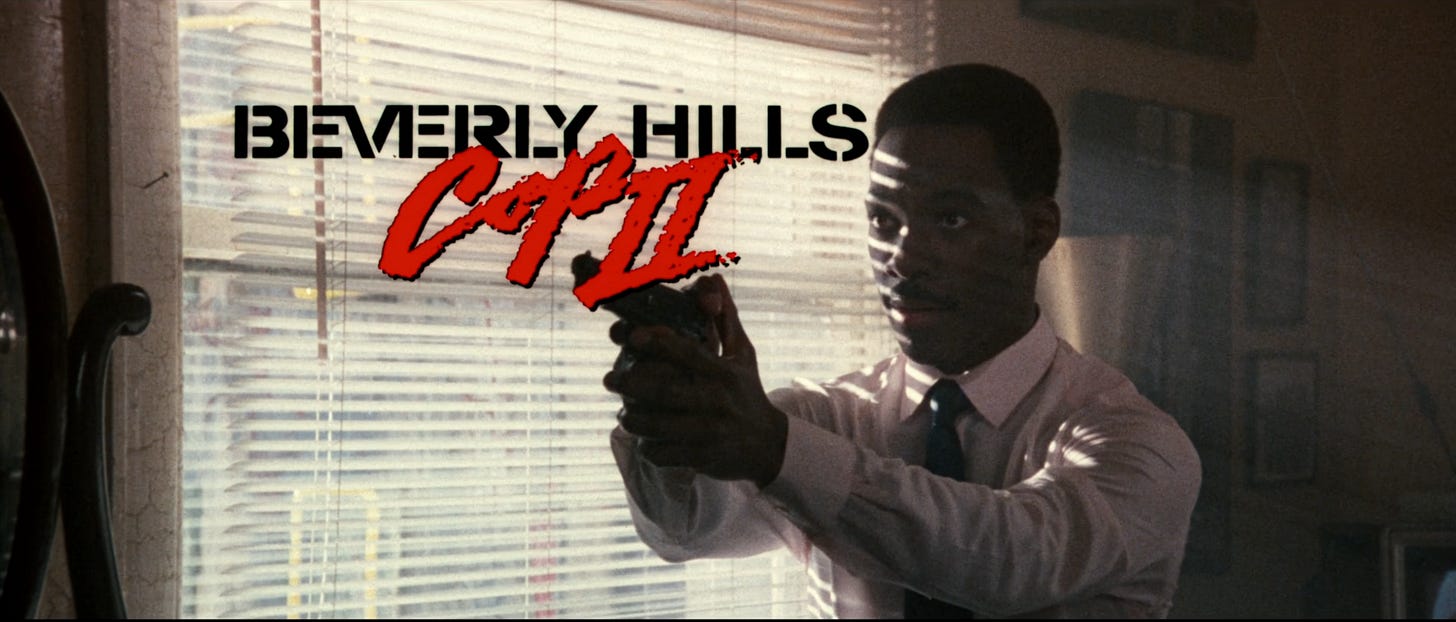
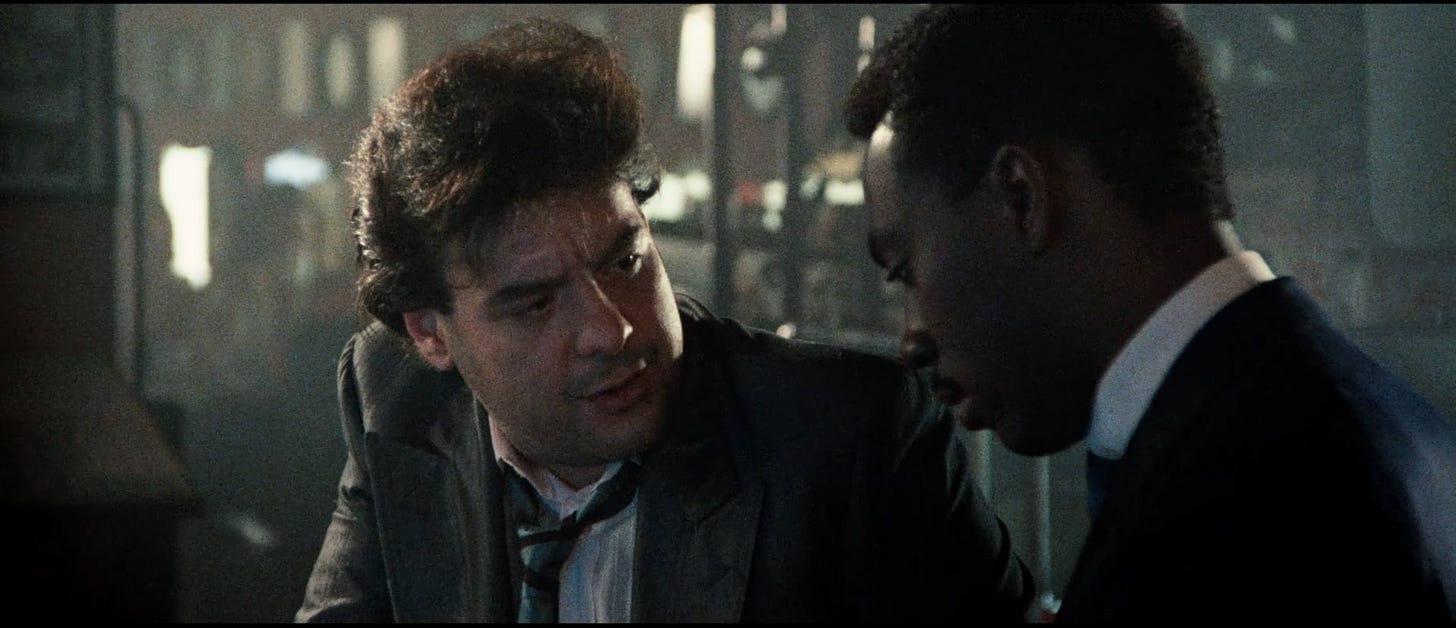
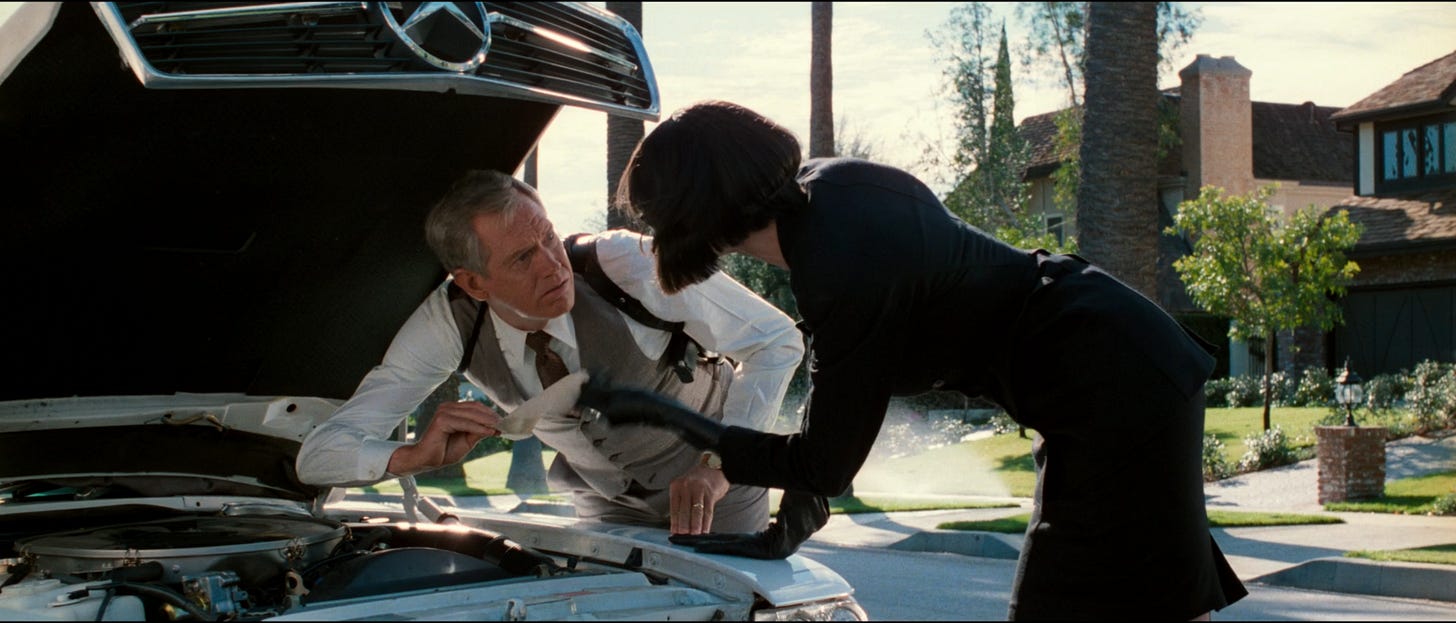

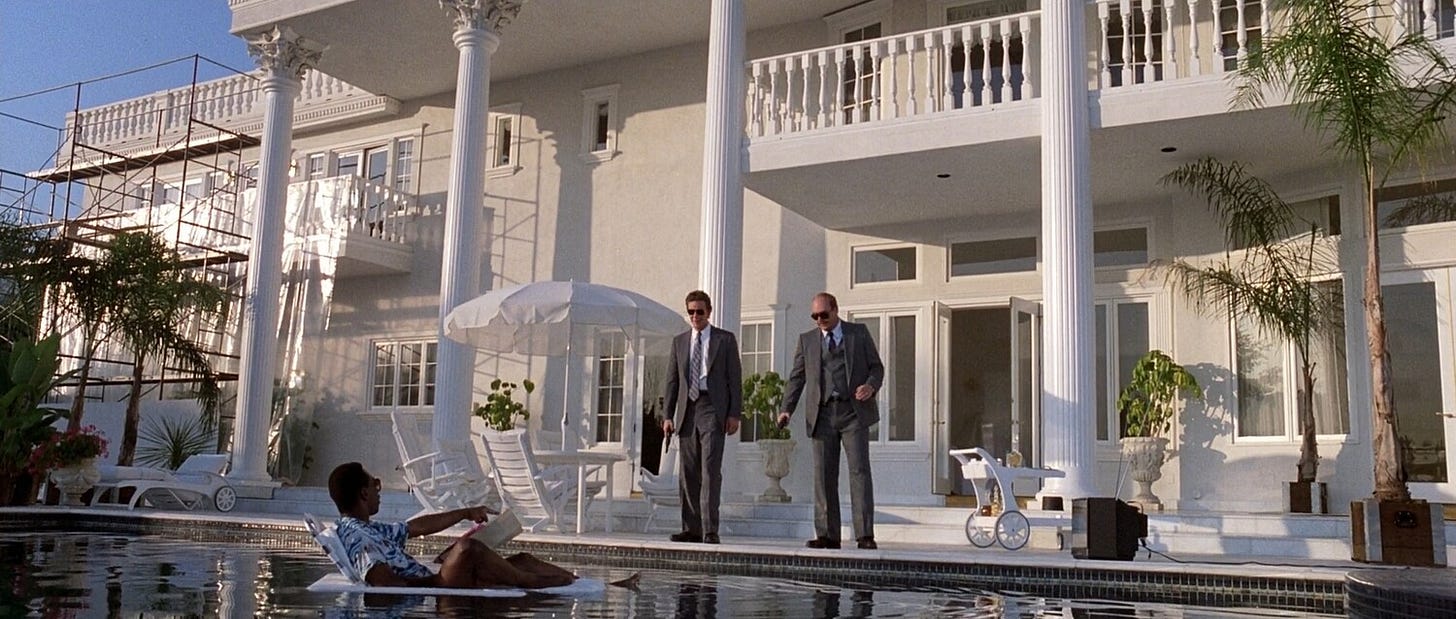
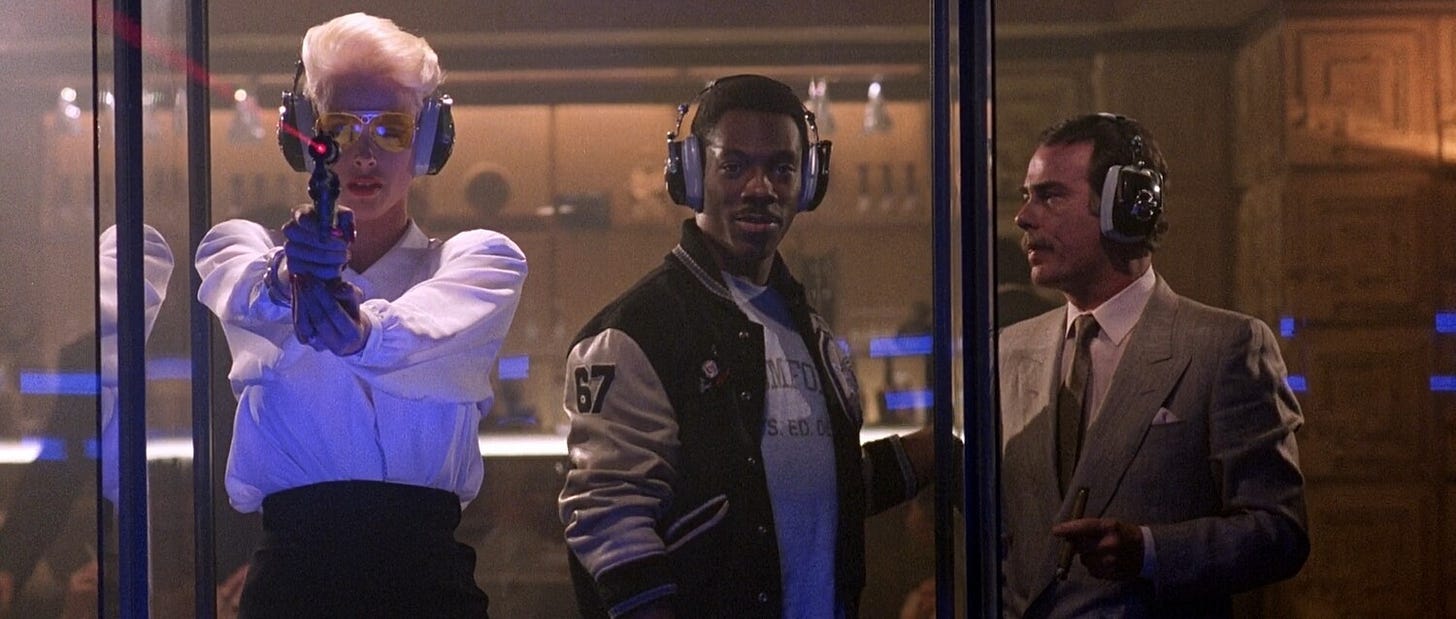
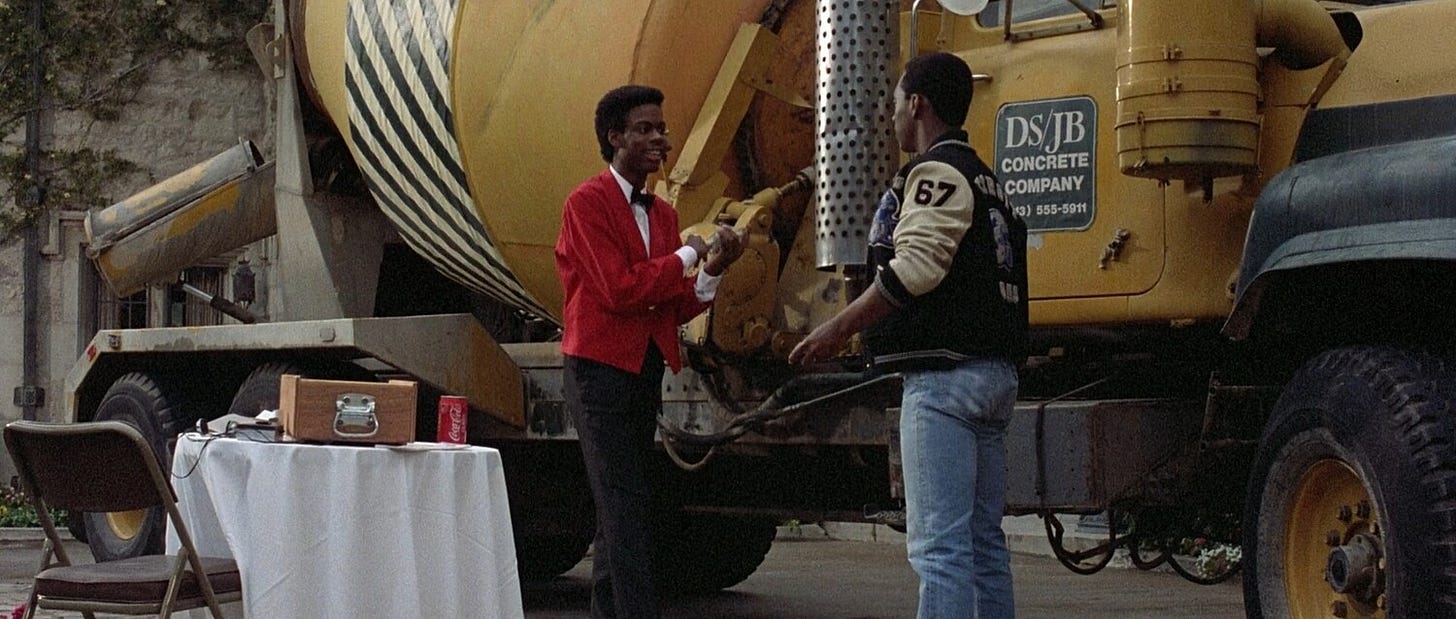
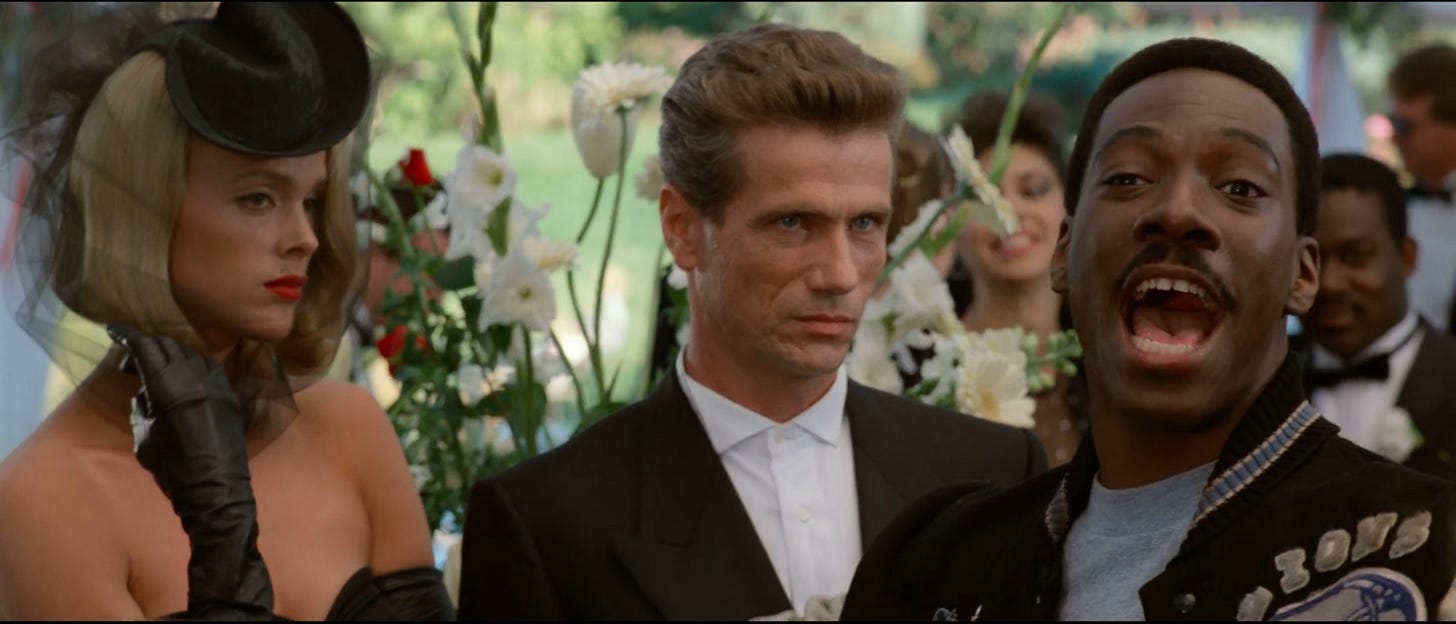

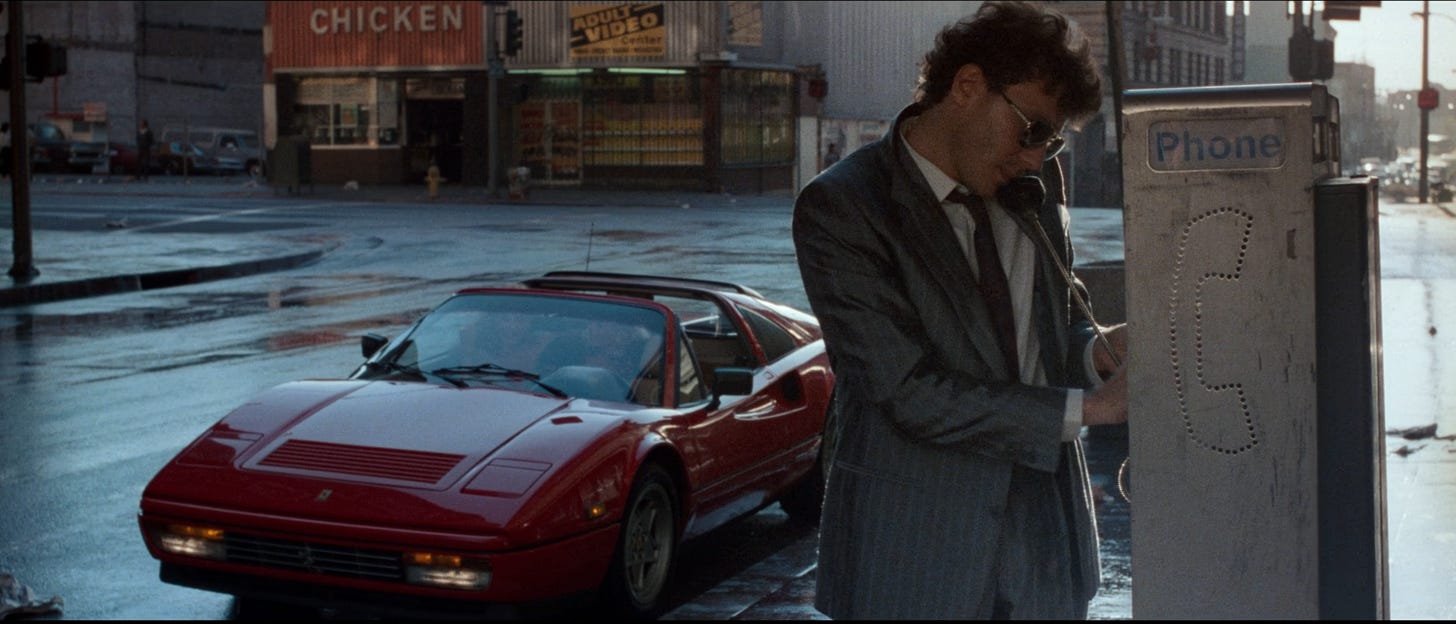
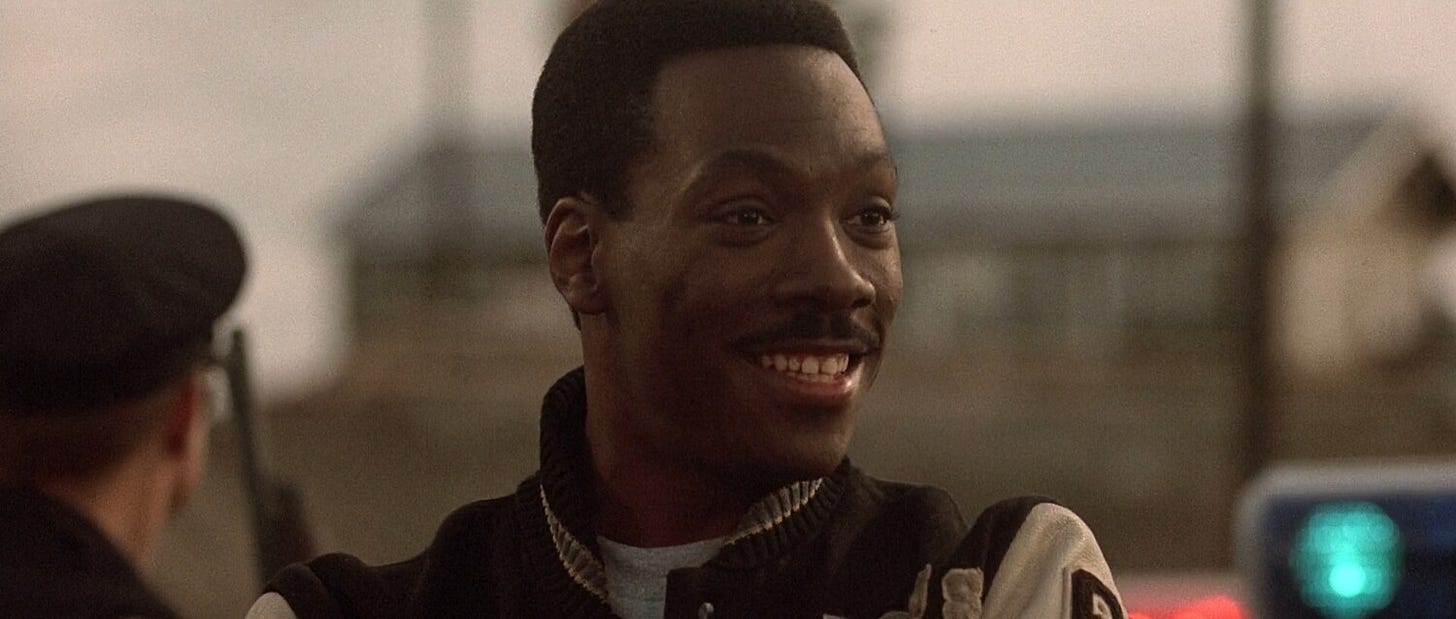
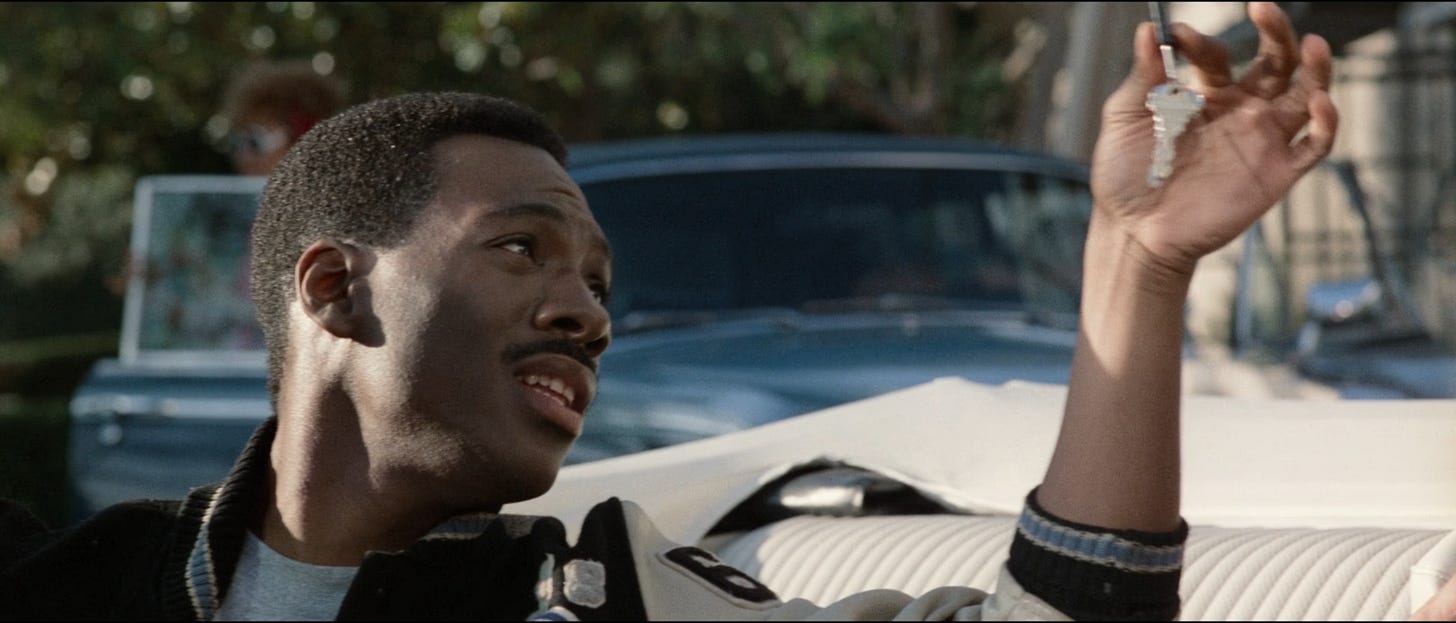
Beverly Hills Cop II was so not funny, and the theme song way over played, and thanks to you, Joe, now I know why… Again, always insightful and informative, thanks Joe! Peace! CPZ